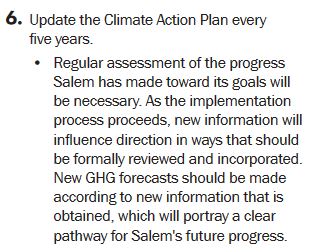The Oregonian today has a front page piece about the ravenous appetite for electricity and the corresponding emissions from our online habits and data centers.
 |
| Oregonian, front page today |
It focuses on the emissions as
a byproduct of Oregon tax policy and represent a profound setback for the state's energy aspirations...hundreds of millions of dollars in local tax breaks to subsidize a constellation of enormous, power-hungry data centers...where the regional power grid has little access to renewable energy.A critic says
Oregon regulators and lawmakers haven't created policies and incentives that encourage economic growth powered by renewable energy.Among other things it is a failure of our climate action goals to be applied to new situations.
More locally, earlier this month the City formally wrote to the Legislature in support of SB 1572, for a study of expanding rail to Salem on the old Oregon Electric line.
 |
| City support for SB 1572 |
The City says it
is taking action to respond to climate change with a Climate Action Plan...[our reduction goals], adopted by City Council in October of 2020, can only be achieved with the collective action of everyone in our community.
Where was this spirit when Council was looking at the airport expansion?!
These two cases show a real gap in our climate plans: They don't have sufficient provision for evaluating new situations and new opportunities.
Our own Climate Action Plan has a closed structure. It does not have provision to see or evaluate anything outside of itself.
 |
| The first page of 176-item "Strategy List" |
It is a list of about 180 discrete strategies (this source says 176, others say 183; there is a bit of inconsistency on the total number).
 |
| Not very strong on new things |
It does not envision taking our overall emissions goal and using that to evaluate new policy decisions. The plan is limited to the specific "strategies" enumerated, and has no specific mechanism to review, revise, and add in the future. Its direction on updating every five years is vague. It has no "strategy" for evaluating novel, unlisted cases. It's more than a little bit of a box-checking exercise. High level values, in this case our overall emissions goal, do not drive it in any on-going, dynamic way.
Since commercial air flight and airport expansion was not included in the original list, it has been exempt from any climate and emissions analysis.
We will doubtless encounter other new possibilities and policy decisions that are not envisioned in the plan.
As a closed document, it's a little dead, and it and our broader use of it need to be made more living.


5 comments:
I would add that politicians always want to look like they're doing something for jobs or the "economy" so they pick a sector and direct a lot of money towards it. Then they have to spend money to mitigate the negative effects or clean up the mess when it implodes.
Real leaders try to look at the downstream effects of their actions. Poll watchers only care if it's going to improve their chances of re-election. Then when the real bill comes due they're long gone. The irony for Salem's leasers is that they're facing difficult budgeting choices because of the bad decisions from decades ago.
I wonder if they call energy from bonneville as renewable? Could be a definition of terms issue. As hydropower is low carbon but often gets classified as non renewable due to negative externalities
The problem is not definitional. The region gets an allocation of hydropower that goes to existing customers. The data centers add large new demand, and to satisfy it the utility has to purchase power on the open market, and that is nearly always dirty fossil fuel power. (Unfortunately the piece is paywalled, and the clip here is not exactly clear on that.)
Fair.
I wonder if it's a chicken and egg problem then?
Without demand it is difficult to justify judge expenditures in building out transmission lines and green energy infrastructure.
I remember reading an article that oregon had untapped clown energies resources, not including hydro. Oregon is also pretty water rich, which data centers require a lot of for cooling.
One of the big ones was this,
https://www.pnnl.gov/news-media/floating-offshore-wind-could-bring-billions-value-west-coast-report-shows
Another interesting idea would be to allow data centers to utilize small scale nuclear reactors
https://www.canarymedia.com/articles/nuclear/a-small-modular-nuclear-reactor-just-got-us-approval-a-big-milestone
Post a Comment